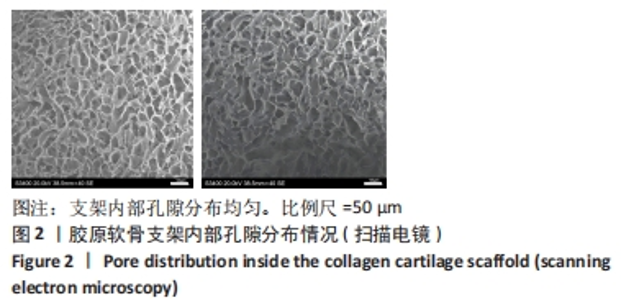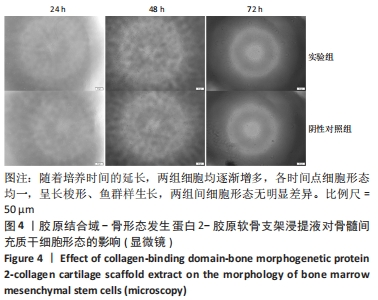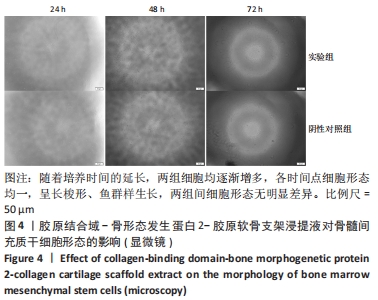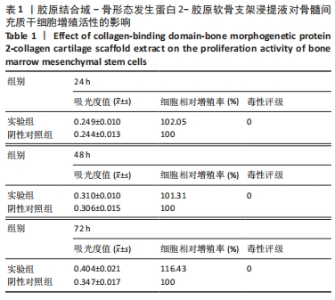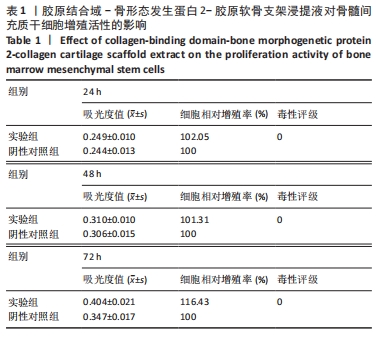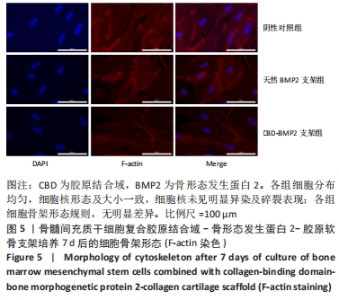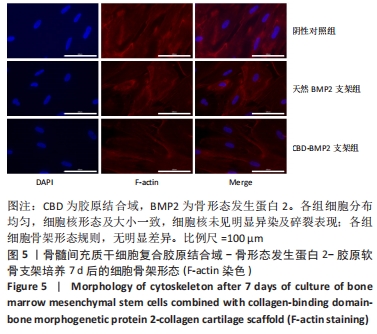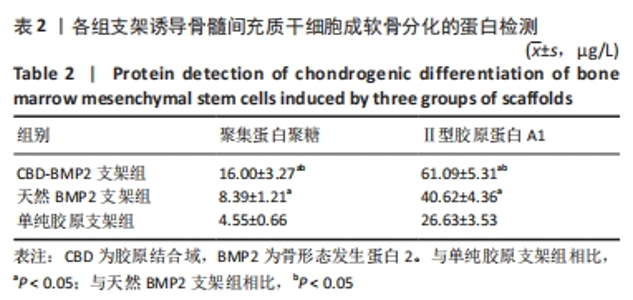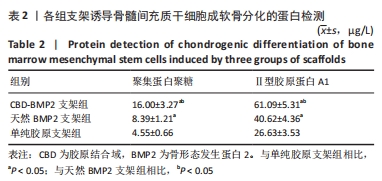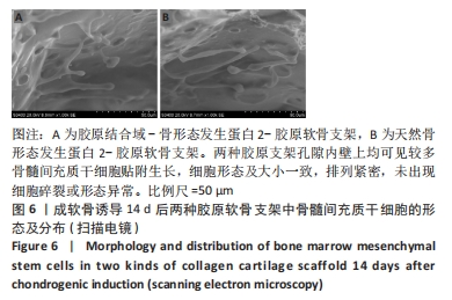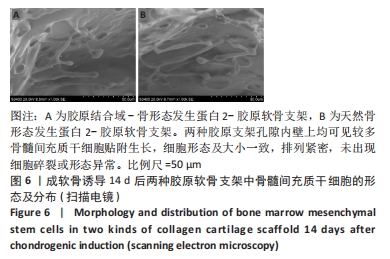Chinese Journal of Tissue Engineering Research ›› 2024, Vol. 28 ›› Issue (15): 2378-2384.doi: 10.12307/2024.403
Previous Articles Next Articles
Preparation of collagen-binding domain-bone morphogenetic protein 2-collagen cartilage scaffold and its chondrogenic induction
Wang Buyu, Zhang Yong, Ruan Shiqiang, Deng Jiang
- Department of Orthopedics, Third Affiliated Hospital (The First People’s Hospital of Zunyi) of Zunyi Medical University, Zunyi 563000, Guizhou Province, China
-
Received:2023-05-08Accepted:2023-07-04Online:2024-05-28Published:2023-09-23 -
Contact:Ruan Shiqiang, MD, Chief physician, Master’s supervisor, Department of Orthopedics, Third Affiliated Hospital (The First People’s Hospital of Zunyi) of Zunyi Medical University, Zunyi 563000, Guizhou Province, China Deng Jiang, Professor, Chief physician, Doctoral supervisor, Department of Orthopedics, Third Affiliated Hospital (The First People’s Hospital of Zunyi) of Zunyi Medical University, Zunyi 563000, Guizhou Province, China -
About author:Wang Buyu, Physician, Department of Orthopedics, Third Affiliated Hospital (The First People’s Hospital of Zunyi) of Zunyi Medical University, Zunyi 563000, Guizhou Province, China -
Supported by:Guizhou Provincial Science and Technology Plan Project, No. ZK[2021]393 (to RSQ); Science and Technology Fund Project of Guizhou Provincial Health Commission, No. gzwkj2021-259 (to RSQ); A Technology Research and Development Project Jointly Funded by Zunyi Science and Technology Bureau and The First People’s Hospital of Zunyi, No. HZ(2019)186 (to RSQ); Guizhou Provincial Science and Technology Plan Project, No. LC[2022]029 (to RSQ)
CLC Number:
Cite this article
Wang Buyu, Zhang Yong, Ruan Shiqiang, Deng Jiang. Preparation of collagen-binding domain-bone morphogenetic protein 2-collagen cartilage scaffold and its chondrogenic induction[J]. Chinese Journal of Tissue Engineering Research, 2024, 28(15): 2378-2384.
share this article
Add to citation manager EndNote|Reference Manager|ProCite|BibTeX|RefWorks

2.2 CBD-BMP2胶原结合能力检测结果 CBD-BMP2、天然BMP2的胶原结合率分别为(95.21±3.48)%,(74.64±4.56)%,组间比较差异有显著性意义(P < 0.05)。 2.3 CBD-BMP2和天然BMP2体外生物活性测定结果 碱性磷酸酶是细胞在成骨分化时表达水平明显升高的一种诱导酶,可作为骨髓间充质干细胞成骨分化标志之一。结果显示,两组BMP2均可诱导MC-3T3-E1细胞成骨生长,CBD-BMP2组的碱性磷酸酶平均活性为(29.34±2.60) kU/L,天然BMP2组碱性磷酸酶活性为(29.23±2.44) kU/L,组间比较差异无显著性意义(P > 0.05),说明CBD-BMP2体外生物活性与天然BMP2一致。 2.4 支架中CBD-BMP2和天然BMP2体外释放实验结果 在各个时间段,CBD-BMP2组的BMP2释放量均小于天然BMP2 (P < 0.05)。在释放中期(12 h-3 d),天然BMP2组支架中BMP2的释放速率逐渐增快,而CBD-BMP2组支架中BMP2释放速率则基本不变,并且释放出的BMP2总量低于天然BMP2组(P < 0.05);3 d以后,CBD-BMP2组仍然保持着较低且速率不变的BMP2释放速率,而天然BMP2组BMP2释放速率逐渐放缓,见图3。表明CBD-BMP2对胶原蛋白的亲和性良好,二者结合可使BMP2达到缓慢释放的目的,有利于BMP2在体内长期发挥成软骨效应。"
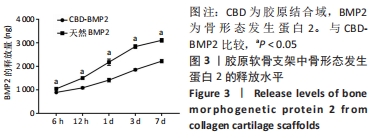
| [1] MORADI M, PARVIZPOUR F, ARABPOUR Z, et al. Articular Cartilage Injury; Current Status and Future Direction. Curr Stem Cell Res Ther. 2023:18. doi: 10.2174/1574888X18666230418121122. [2] BAO Z, CHEN M, LI C, et al. Monosodium iodoacetate-induced subchondral bone microstructure and inflammatory changes in an animal model of osteoarthritis. Open Life Sci. 2022;17(1):781-793. [3] 王新伟,赵英杰,常艳,等.间充质干细胞治疗骨关节炎软骨损伤:作用、应用与问题[J].中国组织工程研究,2021,25(31):5053-5058. [4] TALESA G, MANFREDA F, PACE V, et al.The treatment of knee cartilage lesions: state of the art. Acta Biomed. 2022;93(4):e2022099. [5] YU H, HUANG Y, YANG L. Research progress in the use of mesenchymal stem cells and their derived exosomes in the treatment of osteoarthritis. Ageing Res Rev. 2022;80:101684. [6] YAMASHITA A, TSUMAKI N. Recent progress of animal transplantation studies for treating articular cartilage damage using pluripotent stem cells. Dev Growth Differ. 2021;63(1):72-81. [7] ZELINKA A, ROELOFS AJ, KANDEL RA, et al. Cellular therapy and tissue engineering for cartilage repair. Osteoarthritis Cartilage. 2022; 30(12):1547-1560. [8] 阮世强,邓江,鄢陵,等.聚乳酸/聚羟基乙酸共聚物支架复合骨形态发生蛋白2基因增强的脂肪干细胞促进软骨缺损修复[J].中国组织工程研究,2018,22(6):840-845. [9] CUI Y, XU B, YIN Y, et al. Collagen particles with collagen-binding bone morphogenetic protein-2 promote vertebral laminar regeneration in infant rabbits. Biomed Mater. 2020;15(5):055008. [10] ADDI C, MURSCHEL F, CRESCENZO GD. Design and Use of Chimeric Proteins Containing a Collagen-Binding Domain for Wound Healing and Bone Regeneration. Tissue Eng Part B Rev. 2017;23(2):163-182. [11] ZHANG J, ZHANG Y, JIANG YK, et al. The effect of poly(lactic-co-glycolic acid) conduit loading insulin-like growth factor 1 modified by a collagen-binding domain on peripheral nerve injury in rats. J Biomed Mater Res B Appl Biomater. 2022;110(9):2100-2109. [12] ZHAO C, XIAO Y, LING S, et al. Structure of Collagen. Methods Mol Biol. 2021;2347:17-25. [13] CHEN B, LIN H, ZHAO Y, et al. Activation of demineralized bone matrix by genetically engineered human bone morphogenetic protein-2 with a collagen binding domain derived from von Willebrand factor propolypeptide. J Biomed Mater Res A. 2010;80A(2):428-434. [14] ŻYLIŃSKA B, SOBCZYŃSKA-RAK A, LISIECKA U, et al. Structure and Pathologies of Articular Cartilage. In Vivo. 2021;35(3):1355-1363. [15] CAI Z, CUI Y, WANG J, et al. A narrative review of the progress in the treatment of knee osteoarthritis. Ann Transl Med. 2022;10(6):373. [16] LIU Y, SHAH KM, LUO J. Strategies for Articular Cartilage Repair and Regeneration. Front Bioeng Biotechnol. 2021;9:770655. [17] NIKHIL A, KUMAR A. Evaluating potential of tissue‐engineered cryogels and chondrocyte derived exosomes in articular cartilage repair. Biotechnol Bioeng. 2022;119(2):605-625. [18] SIMON T, JACKSON D. Articular Cartilage: Injury Pathways and Treatment Options. Sports Med Arthrosc Rev. 2018;26(1):31-39. [19] KRYCH AJ, SARIS DBF, STUART MJ, et al. Cartilage Injury in the Knee: Assessment and Treatment Options. J Am Acad Orthop Surg. 2020; 28(22):914-922. [20] BALIAN G, CLICK EM, BORNSTEIN P. Location of a collagen-binding domain in fibronectin. J Biol Chem. 1980;255(8):3234-3236. [21] LIU J, MENG Z, XU T, et al. A SIRPαFc Fusion Protein Conjugated With the Collagen-Binding Domain for Targeted Immunotherapy of Non-Small Cell Lung Cancer. Front Immunol. 2022;13:845217. [22] ZHAI Y, WANG Q, ZHU Z, et al. Cell-derived extracellular matrix enhanced by collagen-binding domain-decorated exosomes to promote neural stem cells neurogenesis. Biomed Mater. 2021;17(1):014104. [23] WANG YN, SUN N. Application of acellular dermal matrix loaded collagen binding domain-vascular endothelial growth factor patch in urethral wound repair in beagles. Zhonghua Yi Xue Za Zhi. 2021; 101(36):2900-2905. [24] NGUYEN V, MEYERS CA, YAN N, et al. BMP2-induced bone formation and neural inflammation. J Orthop. 2017;14(2):252-256. [25] PARK SY, KIM KH, KIM S, et al. BMP2 Gene Delivery-Based Bone Regeneration in Dentistry. Pharmaceutics. 2019;11(8):393. [26] SALAZAR VS, GAMER LW, ROSEN V. BMP signalling in skeletal development, disease and repair. Nat Rev Endocrinol. 2016;12(4): 203-221. [27] DEVINE JG, DETTORI JR, FRANCE JC, et al. The use of rhBMP in spine surgery: is there a cancer risk? Evid Based Spine Care J. 2012;3:35-41. [28] SHARMA U, PAL D, PRASAD R. Alkaline phosphatase: an overview. Indian J Clin Biochem. 2014;29(3):269-278. [29] MeSFIN A, BUCHOWSKI JM, ZEBALA LP, et al. High-Dose rhBMP-2 for Adults: Major and Minor Complications-A Study of 502 Spine Cases. J Bone Joint Surg Am. 2013;95(17):1546-1553. [30] 袁佳滨,缪雄,栗景峰,等.骨形态发生蛋白2临床应用的不良反应[J].第二军医大学学报,2019,40(9):1010-1014. [31] 黄菲,王海,陈尧清,等.骨形态发生蛋白2信号对肿瘤组织中调节性T细胞分化和浸润的作用[J].中国医学科学院学报,2021, 43(6):897-904. [32] SORUSHANOVA A, DELGADO LM, WU Z, et al. The Collagen Suprafamily: From Biosynthesis to Advanced Biomaterial Development. Adv Mater. 2019;31(1):e1801651. [33] MIE NALTOWSKI MJ, BIRK DE. Structure, physiology, and biochemistry of collagens. Adv Exp Med Biol. 2014;802:5-29. [34] 方洪松,周建林,彭昊,等.组织工程支架材料修复关节软骨缺损[J].中国组织工程研究,2016,20(52):7891-7898. [35] SAITO W, UCHIDA K, UENO M, et al. Acceleration of bone formation during fracture healing by injectable collagen powder and human basic fibroblast growth factor containing a collagen-binding domain from Clostridium histolyticum collagenase. J Biomed Mater Res A. 2014;102(9):3049-3055. [36] KIM DG, KIM EY, KIM YR, et al. Construction of Chimeric Human Epidermal Growth Factor Containing Short Collagen-Binding Domain Moieties for Use as a Wound Tissue Healing Agent. J Microbiol Biotechn. 2015;25(1):119-126. |
| [1] | Zhang Kefan, Shi Hui. Research status and application prospect of cytokine therapy for osteoarthritis [J]. Chinese Journal of Tissue Engineering Research, 2024, 28(6): 961-967. |
| [2] | Ma Zhanhua, Yan Xu, Jiang Yan, Cao Zhengming, Wang Yongkui, Li Dongzhe, Yang Tengyue, Jin Yikai, Fu Su, Zhang Chunlin. Primary cilia/intraflagellar transport mediates mechanics-responsive signaling pathway and promotes osteogenic differentiation of bone marrow stromal stem cells [J]. Chinese Journal of Tissue Engineering Research, 2024, 28(25): 3937-3941. |
| [3] | Pei Jiansheng, Yang Wenjuan, He Jing, Yan Ru, Huang Hui, Jia Shaobin. Bone morphogenetic protein-2 mediated homocysteine promotes vascular calcification [J]. Chinese Journal of Tissue Engineering Research, 2024, 28(25): 4027-4033. |
| [4] | Wang Zewen, Li Chenzhi, Liu Jiahe, Li Yancheng, Wu Mingjian, Cui Yan, Li Zhenhao, Xiong Wanqi, He Ting, Liu Baoyi, Yang Fan. Preparation methods, advantages, and disadvantages of cartilage scaffold materials [J]. Chinese Journal of Tissue Engineering Research, 2024, 28(15): 2404-2409. |
| [5] | Tian Linling, Guo Hairui, Du Xiaoming, Feng Jie, Zhang Xianzhe, Zhang Wenbin, Sun Haoran, Zhang Xiaobin, Wang Jingxia, Hu Yimei, Wang Yi. Advantages and features of nanocomposite hydrogel in treatment of osteoarthritis [J]. Chinese Journal of Tissue Engineering Research, 2024, 28(15): 2410-2415. |
| [6] | Su Kunyang, Chen Bineng, Chen Yiliang, Jin Shaofeng. Strontium ranelate-loaded sodium alginate/collagen hydrogel promotes bone defect repair in osteoarthritis [J]. Chinese Journal of Tissue Engineering Research, 2024, 28(10): 1568-1574. |
| [7] | Yang Zhishan, Tang Zhenglong. YAP/TAZ, a core factor of the Hippo signaling pathway, is involved in bone formation [J]. Chinese Journal of Tissue Engineering Research, 2023, 27(8): 1264-1271. |
| [8] | Wang Jinling, Huang Xiarong, Qu Mengjian, Huang Fujin, Yin Lingwei, Zhong Peirui, Liu Jin, Sun Guanghua, Liao Yang, Zhou Jun. Effects of exercise training on bone mass and bone microstructure in aged osteoporotic rats [J]. Chinese Journal of Tissue Engineering Research, 2023, 27(5): 676-682. |
| [9] | Xie Yingchun, Xu Wenjuan, Li Yuwan. Schnurri3 regulates osteogenic differentiation of C3H10T1/2 cells induced by bone morphogenetic protein 2 [J]. Chinese Journal of Tissue Engineering Research, 2023, 27(33): 5270-5276. |
| [10] | Tang Juan, Yu Donglin, Liu Guoqi, Song Jiaojiao, Zuo Jinhua, Fu Honghai. Osteogenic and angiogenic differentiation of dental pulp stem cells modified by hypoxia-inducible factor-1 alpha gene in vitro [J]. Chinese Journal of Tissue Engineering Research, 2023, 27(24): 3865-3870. |
| [11] | Wang Buyu, Zhang Yong, Li Feifei, Dong Xiaoyu, Deng Jiang, Ruan Shiqiang. Role and application of bone morphogenetic protein 2 in the repair of osteochondral defects [J]. Chinese Journal of Tissue Engineering Research, 2023, 27(20): 3259-3265. |
| [12] | Liang Weiye, Duan Qinghong. Correlation between femur bone morphogenetic protein 2 expression and bone fluoride content in fluorosis rabbits [J]. Chinese Journal of Tissue Engineering Research, 2023, 27(17): 2675-2680. |
| [13] | Zhang Tong, Cai Jinchi, Yuan Zhifa, Zhao Haiyan, Han Xingwen, Wang Wenji. Hyaluronic acid-based composite hydrogel in cartilage injury caused by osteoarthritis: application and mechanism [J]. Chinese Journal of Tissue Engineering Research, 2022, 26(4): 617-625. |
| [14] | Liu Hui, Liu Aifeng, Zhang Yu, Zhang Chao. Advantages and application strategies of hyaluronic acid scaffold in cartilage repair engineering [J]. Chinese Journal of Tissue Engineering Research, 2022, 26(34): 5518-5524. |
| [15] | Wu Chengcong, Wang Fang, Wan Jianshan, Wu Zheng, Sun Rong, Huang Hefei, Qian Xuankun, Ou Hua, Ren Jing. Adenovirus-mediated bone morphogenetic protein 2 induces osteogenic differentiation of rabbit bone marrow mesenchymal stem cells [J]. Chinese Journal of Tissue Engineering Research, 2022, 26(30): 4757-4761. |
| Viewed | ||||||
|
Full text |
|
|||||
|
Abstract |
|
|||||


